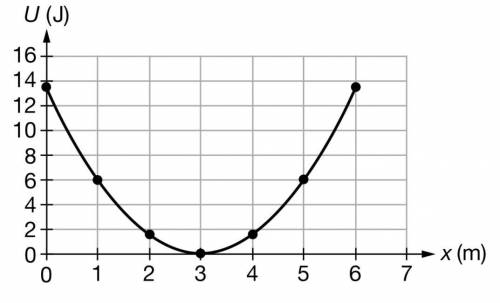
Physics, 04.11.2020 23:10 anonymous777739
An object slides along a curved track of negligible friction, as shown in the figure. The potential energy U of the object as a function of the position x is shown in the graph. The object starts at rest at x=0. Which of the following is a correct claim about the motion of the object?
(Would prefer an explanation, but it's not necessary)
A) The kinetic energy of the object is approximately the same at x=2m and x=5m.
B) At x=2m, the object has more potential energy than kinetic energy.
C) The object comes to rest when x=5.5m.
D) The rate of change of the potential energy is a minimum at x=0m.
E) The object achieves its maximum speed at approximately x=3m.



Answers: 1
Another question on Physics

Physics, 21.06.2019 15:30
Which of the following statements are true of solids? a.the particles do not vibrate. b.the particles are in a fixed location. c.they have strong intermolecular forces between the atoms or molecules. d.the particles have less kinetic energy than those of liquids or gases.
Answers: 1

Physics, 21.06.2019 20:00
Alice added sodium chloride to water and stirred the water for several minutes. alice is most likely trying to demonstrate that ionic compounds a. are hard. b. can dissolve. c. are clear. d. can melt.
Answers: 1

Physics, 21.06.2019 22:50
A23 kg log of wood begins from rest, 300 m up a sluice (a water track used to transport logs, think of it as an inclined plane with negligible friction) inclined at 20° to the horizontal. after it reaches the flat waterway at the bottom it collides elastically with a 100 kg block of wood initially at rest near the base of the incline. (a) how long does it take the 23 kg log to travel down the incline? (b) what is the speed of the 23 kg log at the bottom of the incline? (c) what are the velocities of both blocks of wood after the collision? (d) what is the total kinetic energy before the collision? (e) what is the kinetic energy of the 23 kg log after the collision? (f) what is the kinetic energy of the 100 kg block of wood after the collision? (g) what is the total kinetic energy after the collision? (h) compare the total initial and total final kinetic energies. is this consistent with what you would expect for elastic collisions? explain!
Answers: 1

Physics, 22.06.2019 07:20
Samir watches a 100-minute movie on his spaceship. maria's spaceshipe flies in the same direction as samir's spaceship but she observes his move to last 125 minutes and his spaceship to be 40 m long. how long does samir observe his own spaceship to be? according to an observer on earth, planet x is stationary. maria and samir depart earth on their spaceships at the same time, each flying at 0.5c. maria flies toward planet x and samir flies in the opposite direction. according to maria, her voyage to planet x takes 9 years. how many years does marias voyage take according to samir?
Answers: 3
You know the right answer?
An object slides along a curved track of negligible friction, as shown in the figure. The potential...
Questions



English, 19.10.2019 22:50

Mathematics, 19.10.2019 22:50

Mathematics, 19.10.2019 22:50

Mathematics, 19.10.2019 22:50



Social Studies, 19.10.2019 22:50


History, 19.10.2019 22:50


Mathematics, 19.10.2019 22:50



Mathematics, 19.10.2019 22:50

Mathematics, 19.10.2019 22:50





